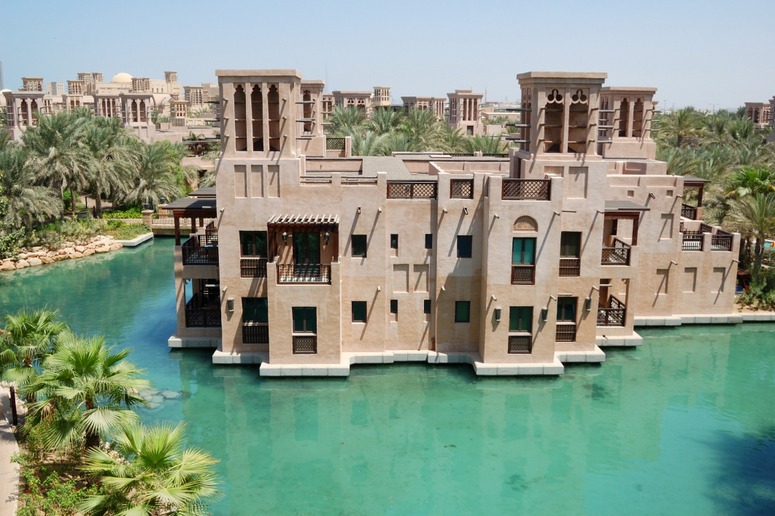HOW to produce context-sensitive design is a very considerable problem – and the Madinat Jumeriah Hotel in Dubai is a case in point:
1. the character of the design is unmistakably West Asian (though more Persian than Arabian)
2. the design style is popular with both Arab and European visitors
3. I would rather stay in this hotel than in an Anywhere Style modern block
4. I guess the idea of building in this style would be condemned in most of the world’s architecture schools, by most of the world’s architects and by most of the world’s architectural critics
5. wind-towers (badgirs) were a brilliant Persian contribution to the art of air conditioning, but the badgirs in the photographs are fakes, probably used for mechanical plant or as storage space for crates of beeri
6. it is completely non-traditional to surround Arab palaces with water – and the Madinat Jumeriah Hotel does not exemplify a sustainable approach to hydrological design
7. the planting design style in the hotel gardens is more authentic than in the great majority of surviving Islamic gardens, though it is quite a way from the tradition of uderplanted palm orchards
So is the Madinat Jumeriah Hotel in Dubai an example to follow or an example to avoid? (10 re architectural design? (2) re landscape and garden design? (3) re use of materials and detailed design?
See note: How should a design project relate to its context?


Comment from Christine: Well I suppose one answer is that the architectural and landscape design is more contextually sensitive than it would be if it were located at Las Vegas in the Nervada desert. [ http://www.bugbog.com/gallery/usa_pictures/las_vegas_pictures/las_vegas_pictures.html ]
The Madinat Jumeriah Hotel in Dubai 1 and 2) belongs aesthetically to the tradition of Middle Eastern architecture and landscape. 3) Is obviously a modern re-presentation of that tradition
All good points. I had a friend who had done national service in Aden and who studied architecture in the 1960s. He tried to do what we now call context-sensitive design for his school projects – and they failed him for not trying to be contemporary. As he saw the tide turn over the next 40 years he became ever-crosser with his former tutors at Edinburgh College of Art.
Yes this is a problem. The process of learning often means realism precedes abstraction. Often while the lessons of the past are being absorbed by the student the fact that the student is learning about architecture/landscape is not recognised.
When contemporary architectural sources are used in the same way (ie. a student’s work resembles that of a contemporary design guru) this is less of a difficulty for design schools.
I am not sure what the answer to this problem is. (Perhaps closer questioning of the student’s interests and intentions expressed within the project?)